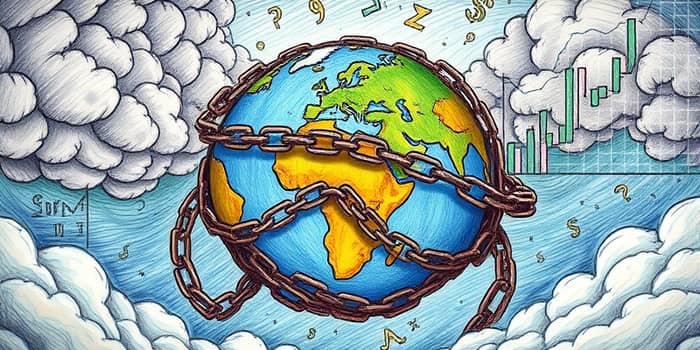
Global economies are navigating an era of unprecedented borrowing. As debt climbs to historic heights, policy makers and citizens alike face difficult choices around growth, priorities, and resilience.
This article explores the evolving debt landscape, regional disparities, financial risks, expert analyses, and potential solutions to safeguard global stability.
As of 2024, the total global debt stood at an astonishing $318 trillion, marking a rise of nearly $7 trillion from the previous year. For the first time in four years, the debt-to-GDP ratio inched upward, driven by slower GDP growth and easing inflation pressures.
Public debt alone accounted for approximately $100 trillion, with mounting borrowing costs squeezing national budgets and crowding out essential investments. While governments sought to support pandemic recovery and green transitions, higher financing bills have limited their fiscal flexibility.
The trend persisted into 2025, with global debt surpassing $324 trillion by the first quarter. Analysts warn that if left unchecked, this upward trajectory could threaten the very foundations of economic resilience.
Not all regions have been affected equally. Economic structures, policy responses, and external vulnerabilities have produced divergent outcomes across the globe.
In the Arab world, oil-rich Gulf Cooperation Council (GCC) states such as Saudi Arabia and Qatar maintained relatively stable debt levels, buoyed by strong energy revenues. Conversely, non-GCC countries like Egypt and Lebanon have grappled with soaring obligations amid currency devaluations and political uncertainty.
Developing nations, particularly in Sub-Saharan Africa and parts of Latin America, face acute pressure. Over 50 countries now dedicate more than 10% of their revenues to debt servicing, and 3.3 billion people live in nations where debt interest surpasses education or health spending. Limited access to affordable refinancing options has left many at high risk of default.
High indebtedness has far-reaching consequences for growth, stability, and social well-being.
These pressures can stifle innovation and deepen inequality, creating a cycle that further undermines long-term prosperity.
Leading institutions and thought leaders have sounded alarms about the perils of unchecked debt accumulation.
The International Monetary Fund emphasizes the need for sustainable growth policies and frameworks that balance stimulus with prudent fiscal management. In their view, failing to address public debt levels now could leave economies poorly prepared for future shocks.
At the World Economic Forum, chief economists cautioned that current trajectories undermine efforts to boost productivity and resilience. They highlighted an optimism bias in many forecasts, urging policy makers to prepare for downside scenarios.
Insights from Davos 2025 reinforced these warnings. Experts called for transparent debt reporting, enhanced multilateral coordination, and more robust stress-testing of sovereign exposures.
Despite the daunting figures, there are avenues to alleviate debt stress and restore financial stability.
At the same time, structural reforms—ranging from energy transition strategies to labor market enhancements—are vital for boosting growth potential and underpinning sustainable debt trajectories.
Looking ahead, the debt burden is expected to keep growing unless decisive action is taken.
Analysts foresee that, absent structural change, global debt could exceed $350 trillion by the end of the decade. This escalation poses significant risks to financial stability, including potential sovereign defaults, bank losses, and renewed economic downturns.
Building resilience against debt-related shocks requires a multifaceted approach:
By combining prudent policy measures with innovative financial instruments, stakeholders can work together to mitigate risks and foster a more stable economic environment.
Ultimately, global debt management is not just a balance-sheet exercise; it is a critical determinant of our collective future. Through informed policy choices, strengthened institutions, and shared commitment to sustainable growth, the world can steer away from the brink and toward a more prosperous and secure tomorrow.
References













